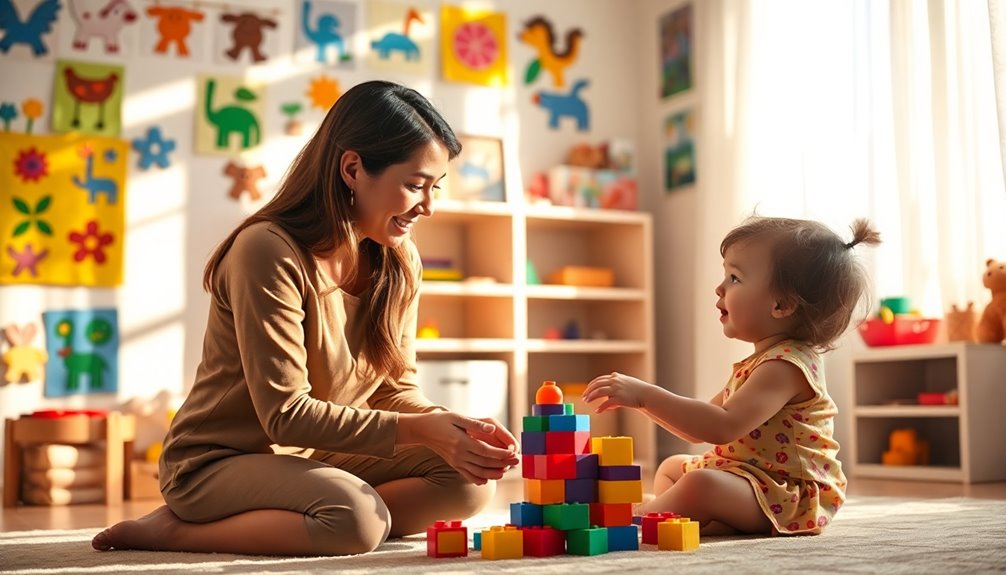Responsive caregiving is all about noticing and responding to your child’s cues, like their gestures and sounds. It plays an essential role in their emotional and cognitive development, helping them feel secure and valued. When you engage consistently, it lays a strong foundation for their brain growth, problem-solving skills, and social abilities. Despite challenges, your responsiveness can foster deeper connections. Stick around to discover how you can enhance your caregiving skills for even better outcomes.
Key Takeaways
- Responsive caregiving involves noticing and responding to children’s cues to support their emotional and physical well-being.
- It fosters secure attachments, crucial for a child’s emotional health and development.
- Higher responsiveness leads to improved cognitive skills, problem-solving abilities, and better psychosocial outcomes.
- Responsive caregiving is essential for infants and toddlers, laying the foundation for learning and emotional resilience.
- Challenges such as distractions and environmental stressors can impact caregivers’ ability to respond consistently.
Understanding Responsive Caregiving

Understanding responsive caregiving is essential because it directly impacts a child’s emotional and physical well-being. As a caregiver, you’re responsible for noticing and responding to young children’s cues, such as gestures and sounds. This interaction fosters secure attachments, important for their emotional health.
Responsive caregiving plays a pivotal role in child development, influencing brain growth, cognition, and problem-solving skills. Research shows that higher levels of responsiveness correlate with better psychosocial and cognitive outcomes, particularly in low- and middle-income families.
Each improvement in your caregiving quality can lead to enhanced feelings of safety and trust in children. In turn, these feelings are critical for effective learning and overall development, making your role even more significant.
Importance for Infants and Toddlers

Responsive caregiving is particularly important for infants and toddlers, as it lays the foundation for their emotional and cognitive development. When you practice responsive caregiving, you send a powerful message to young children that their needs matter and will be met, fostering safety and security.
This emotional support is essential for healthy brain development, influencing their cognition, problem-solving skills, and learning outcomes. Consistent responsive caregiving helps young children develop strong social skills and emotional resilience, which are critical for their overall child health. Research shows that this approach can improve psychosocial outcomes, especially in adverse conditions. As a care provider, engaging in responsive caregiving allows infants and toddlers the freedom to explore and learn, feeling supported and understood. Additionally, critical periods in development highlight the importance of timely responses to children’s needs.
Challenges Faced by Caregivers

While the goal of responsive caregiving is to meet a child’s needs, caregivers often encounter significant challenges that can hinder their ability to do so effectively.
You may find yourself pulled in multiple directions, making it tough to respond promptly to your child’s emotional signals. Viewing caregiving as an art rather than a science can lead to inconsistencies in how you interpret these signals.
Additionally, maintaining consistent responsiveness is essential for your child’s health and development, yet stressors and distractions in your environment make this difficult. Strong social relationships can help motivate you, but the demands of child care can strain these connections.
Despite these hurdles, working hard to be responsive fosters secure attachments and promotes healthy development in your child.
How CCR&Rs Support Responsive Caregiving

As you navigate the complexities of caregiving, Child Care Resource and Referral (CCR&R) organizations play an essential role in supporting your efforts to provide responsive care.
They equip you with crucial resources that foster an environment where your young child feels safe and nurtured.
CCR&Rs offer:
- Referrals and consumer education on responsive caregiving practices
- Accessible tips and short videos on their websites
- Information in referral resources to help your child choose quality care
- Training for technical assistance specialists to support providers
- Advocacy for responsive caregiving training for infant and toddler caregivers
Long-term Benefits of Responsive Caregiving

When you prioritize responsive caregiving, you’re laying a foundation for your child’s long-term well-being. By tuning into your child’s signals, you foster secure attachments, which are essential for healthy emotional regulation.
This strong bond not only supports your child’s immediate needs but also enhances cognitive skills, problem-solving abilities, and language development. Research shows that every increase in responsive caregiving correlates with improved socioemotional outcomes, illustrating its lasting impact.
Children who experience consistent responsive care are more likely to thrive socially, displaying resilience to stress and maintaining better mental health throughout life.
Ultimately, the long-term benefits of responsive caregiving extend well beyond childhood, shaping your child’s future relationships and overall adaptability.
Frequently Asked Questions
What Are Examples of Responsive Caregiving?
Examples of responsive caregiving include holding your child close during feedings to foster emotional bonds and talking to them during diaper changes to create a sense of security.
When your child cries, you respond quickly, interpreting their needs and comforting them. Engaging in eye contact and mirroring their expressions helps build trust, while consistent daily routines reinforce that their needs will be met, promoting healthy social and emotional development.
What Are the Components of Responsive Caregiving?
The components of responsive caregiving include nurturing touch, verbal communication, and engaging in daily routines.
By recognizing and interpreting your child’s cues—like gestures and expressions—you create a secure environment. Responding sensitively and promptly to their needs builds trust and emotional security.
This approach not only fosters a strong bond but also supports your child’s learning and development, enhancing their communication and problem-solving skills as they grow.
What Does Responsive Care Mean?
Responsive care means you’re tuning into a child’s needs by noticing their cues—like cries or smiles—and reacting appropriately.
It’s about creating a nurturing environment where the child feels understood and secure.
When you respond promptly and sensitively, you’re not just meeting their immediate needs; you’re also building a strong emotional bond.
This connection is vital for their overall development and helps them learn to communicate and problem-solve effectively as they grow.
Why Is Caregiver Responsiveness Important?
“Actions speak louder than words.” Caregiver responsiveness is essential because it builds a secure attachment, helping you foster emotional regulation in children.
When you respond consistently, you empower them to face challenges and develop resilience. This connection enhances their problem-solving skills and social engagement, laying the groundwork for positive relationships.
A nurturing environment encourages exploration and learning, ultimately supporting their brain development and contributing to long-term emotional well-being.
Conclusion
To sum up, responsive caregiving is essential for nurturing healthy development in infants and toddlers. By tuning into their needs, you’re not just providing care; you’re laying the groundwork for their future. Remember, “It takes a village to raise a child.” Embracing this approach not only helps you as a caregiver but also strengthens the bond with the little ones in your life. So, keep engaging and responding—you’re making a lasting impact!









